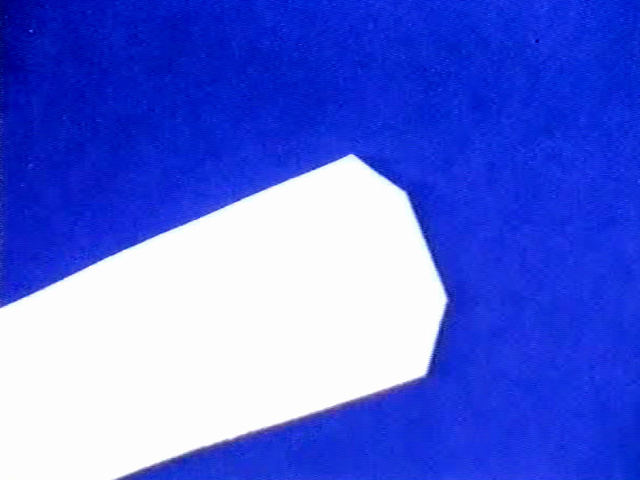
Hard-edged solid shapes – drawn on cards with a knife and ruler, and linear 3-D shapes rotate in space, alternate with each other, and optically disintegrate.
EN
“We look at Breer’s work and we begin to smile – lightly, a happy sort of smile, a happy feeling like when you see anything beautiful and perfect. It’s through an amazing control and economy of his materials that he achieves this; through the elimination of all the usual emotional, personal, biographical, sick material; by not giving in to temptations.”
Jonas Mekas1
Robert Breer: Actually, any disruption of normal thought patterns is bound to have an effect, and people often will call that “disorder.” Some people stalk out of my films, and are angered. I’d like to think that out of that reaction, people will eventually be brought to see the films as I see them.
Guy L. Coté: But what about boredom? What about the people that are bored by your films?
Ah, boredom. I’m against boredom. I can work with outrage, but I’m sorry to have to bore anyone. If I had to choose, I’d much rather anger them, though I should say that the eventual goal is pleasure, viz. joy.
Robert Breer in conversation with Guy L. Coté2
“So what’s really different is the edge between 3 dimensional illusion and 3D reality. This is a new proscenium – possibly. It has to do with revealing the artifices instead of concealing them. The fact of that rabbit sitting inside the magician’s hat is the real mystery, not how it’s dissimulated. The hat should be transparent and show the rabbit.”
Robert Breer3
Jonas Mekas: This is a silly question, but could you try to sum up, what, for you, cinema is, as opposed to painting? Are those two directions, areas, clear?
Robert Breer: I use the word “threshold” a lot, when I am thinking about what I am doing. I have a notion about conventions or disciplines, they are inter-changeable words for me. The sum total of the, let’s say, cultural history of the…
[Interruption]
Yes, we were on the word “threshold”.
Yes. Somewhere, in all my work, I tried to amaze myself with something, and the only way you can amaze yourself is to create a situation in which an accident can happen. The accident is relative to what you’re trying to do. It’s only an accident because it’s unforeseen. And somehow it always gave me that opportunity. It’s narrowing down now, in such a way that the accidents are smaller and smaller… That’s the terrible thing that happens with the kind of control that you have. Still, it’s very important. And that’s where I consider the threshold of what I know about a given medium and what happen when I violate that threshold at the moment I consider I am doing something worth pursuing. So, every film has to get me interested, while I’m doing it. This has to happen somewhere along the line. It’s a notion, like… It’s probably an old idea about avantgarde, you know, about breaking ground and about defining limits of something by breaking those limits all the time. I consider limits very important, if only to serve as a basis for rupturing, you know? This is the only reason for doing this thing, it’s a matter of bringing life into something. You break a leg and you know what your are made of; if you get sick, then you know what you are, or, maybe in a more positive way, if you have some great paroxysm of joy. I mean, sexual revelation, all kinds of physical revelations, like that. And in an art form, it takes a more formalistic…
Robert Breer in conversation with Jonas Mekas and P. Adams Sitney4
- 1Jonas Mekas, Movie Journal. The Rise of the New American Cinema, 1959-1971 (New York: Columbia University Press, 2016), 184.
- 2Guy L. Coté, “Interview with Robert Breer,” Film Culture, no. 27, 1962/63, p. 20.
- 3Robert Breer, “Letter from Robert Breer to Jonas Mekas,” Film Culture, no. 56-57, Spring 1973.
- 4Jonas Mekas & P. Adams Sitney, “Interview with Robert Breer,” Film Culture, no. 56-57, Spring 1973.

